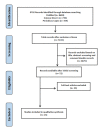Clinical, Radiographic and Histopathological Analysis of Craniopharyngiomas and Ameloblastomas: A Systematic Review
- PMID: 35920974
- PMCID: PMC9729483
- DOI: 10.1007/s12105-022-01473-2
Clinical, Radiographic and Histopathological Analysis of Craniopharyngiomas and Ameloblastomas: A Systematic Review
Abstract
Background: Craniopharyngiomas and ameloblastomas are tumors of epithelial origin, mostly characterized by a benign course, slow growth and for being locally invasive. Some studies highlight the similarity of these neoplasms, especially regarding histopathological aspects. In this context, the aim of the present study was to carry out a systematic literature review correlating the clinical, radiographic, and histopathological aspects of these two tumors.
Methods: Searches were conducted at the Pubmed, Periódicos Capes, Scopus, Science Direct, Web of Science and Scielo databases, according to the following inclusion criteria: publications in English or Spanish, from the 2000s and 2021, comprising case report studies, case series and literature reviews.
Results: Considering clinical and radiographic aspects, it is evident that craniopharyngiomas and ameloblastomas exhibit few similarities. Histopathologically, however, adamantinomatous craniopharyngiomas are the type of tumor that most resembles ameloblastomas, both concerning the formation of palisade epithelial cords and epithelial formations. Regarding to recurrences in cases of craniopharyngioma, it appears that a more radical surgical resection is more related to a lower recurrence rate for both craniopharyngiomas and ameloblastomas. As for the outcome, it was observed that craniopharyngiomas have a greater relationship with possible systemic disorders.
Conclusions: This histopathological similarity is related to their origin, since both craniopharyngiomas and ameloblastomas share a relationship with the oral cavity, either partially, as in the case of craniopharyngiomas, or totally, as in ameloblastomas, not comprising the same lesion in different locations. It is important to note that the differential morphogenetic evidence observed herein between these lesions opens up a new field of study aiming at better treatment alternatives in the future.
Keywords: Ameloblastoma; Craniopharyngioma; Neoplasm; Pathological conditions; Radiography.
© 2022. The Author(s), under exclusive licence to Springer Science+Business Media, LLC, part of Springer Nature.
Conflict of interest statement
The authors declare that they have no conflicts of interest as it relates to this research.
Figures


Similar articles
-
Home treatment for mental health problems: a systematic review.Health Technol Assess. 2001;5(15):1-139. doi: 10.3310/hta5150. Health Technol Assess. 2001. PMID: 11532236
-
Topotecan, pegylated liposomal doxorubicin hydrochloride and paclitaxel for second-line or subsequent treatment of advanced ovarian cancer: a systematic review and economic evaluation.Health Technol Assess. 2006 Mar;10(9):1-132. iii-iv. doi: 10.3310/hta10090. Health Technol Assess. 2006. PMID: 16545208
-
A rapid and systematic review of the clinical effectiveness and cost-effectiveness of topotecan for ovarian cancer.Health Technol Assess. 2001;5(28):1-110. doi: 10.3310/hta5280. Health Technol Assess. 2001. PMID: 11701100
-
A rapid and systematic review of the clinical effectiveness and cost-effectiveness of paclitaxel, docetaxel, gemcitabine and vinorelbine in non-small-cell lung cancer.Health Technol Assess. 2001;5(32):1-195. doi: 10.3310/hta5320. Health Technol Assess. 2001. PMID: 12065068
-
Interventions for promoting habitual exercise in people living with and beyond cancer.Cochrane Database Syst Rev. 2018 Sep 19;9(9):CD010192. doi: 10.1002/14651858.CD010192.pub3. Cochrane Database Syst Rev. 2018. PMID: 30229557 Free PMC article.
Cited by
-
Association of MDM2 Overexpression in Ameloblastomas with MDM2 Amplification and BRAFV600E Expression.Int J Mol Sci. 2024 Feb 13;25(4):2238. doi: 10.3390/ijms25042238. Int J Mol Sci. 2024. PMID: 38396916 Free PMC article.
-
Implant-supported prosthetic rehabilitation after Ameloblastomas treatment: a systematic review.BMC Oral Health. 2023 Dec 18;23(1):1013. doi: 10.1186/s12903-023-03765-7. BMC Oral Health. 2023. PMID: 38110933 Free PMC article.
-
Comparative Immunohistochemical Analysis of Craniopharyngioma and Ameloblastoma: Insights into Odontogenic Differentiation.Diagnostics (Basel). 2024 Oct 17;14(20):2315. doi: 10.3390/diagnostics14202315. Diagnostics (Basel). 2024. PMID: 39451638 Free PMC article.
-
Clinicopathologic Profile, Management and Outcome of Sinonasal Ameloblastoma-A Systematic Review.J Clin Med. 2023 Jan 3;12(1):381. doi: 10.3390/jcm12010381. J Clin Med. 2023. PMID: 36615180 Free PMC article. Review.
References
-
- Müller H, Merchant T, Warmuth-Metz M, Martinez-Barbera JP, Puget S. Craniopharyngioma. Nat Rev Dis Primers. 2019; 5(1). - PubMed
Publication types
MeSH terms
LinkOut - more resources
Full Text Sources
Medical
Research Materials

